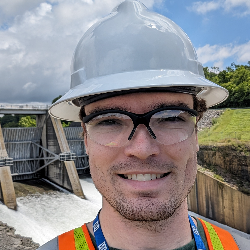
June 2025 Webinar: Modeling Transient Life Loss: A Spatial Sampling Approach for Downstream Consequences
Includes a Live Web Event on 06/26/2025 at 10:00 AM (MDT)
-
Register
- Non-member - $89
- Member - $39
Transient populations can have a significant influence on risks posed by a dam, especially in locations with frequent water recreation downstream of the project. A key operating objective of many dams is to provide safe conditions for recreation within the vicinity of the dam. Dam Safety professionals must consider recreational populations when assessing emergency management plans and downstream consequences. These transient populations can be difficult to capture with conventional consequences modeling techniques which represent transient populations within a structure point dataset. Modeling methods often involve aggregating average annual population data and defining a set of points with fixed locations in the hazard area, potentially biasing risk estimates depending on the location of the point in relation to the terrain and hydraulics. These points do not capture uncertainty related to the transient population’s freedom of movement in the hazard area and do not allow for spatial variability or the representation of varying recreation populations near and within the river channel. Alternative methodologies are presented here which involve random spatial sampling of transient population points within the hazard area, capturing the influence of population density and spatial variability. A population sampling grid is used to redistribute transient populations spatially within a study area hundreds of times, simulating the possibility of a range of population distributions and hazard exposures within a recreation area. Additional methods are also presented to randomly assign population at risk within a study area as well as the modeling of transient populations with the evacuation model in LifeSim. The development of methodologies to better assess impacts to transient populations during breach events will advance risk assessment theory and practice and lead to better decision-making for risk estimators and emergency management agencies.

Matthew Montgomery
Civil Engineer
Tennessee Valley Authority
Matt Montgomery received a bachelor's degree in civil engineering and a master's degree in environmental engineering from the honors college at the University of Tennessee, Knoxville. Mr. Montgomery is currently a civil engineer in the Hydrologic Impacts and Risk Evaluation (HIRE) group at Tennessee Valley Authority (TVA) where he performs hydrologic and hydraulic modeling largely in support of risk assessment for dams in the TVA portfolio. Mr. Montgomery contributes to the determination of hydrologic hazard probabilities by performing statistical analyses on historical data and stochastic model output. In support of downstream consequences assessment, he performs dam breach hydraulic modeling and downstream consequences modeling.
